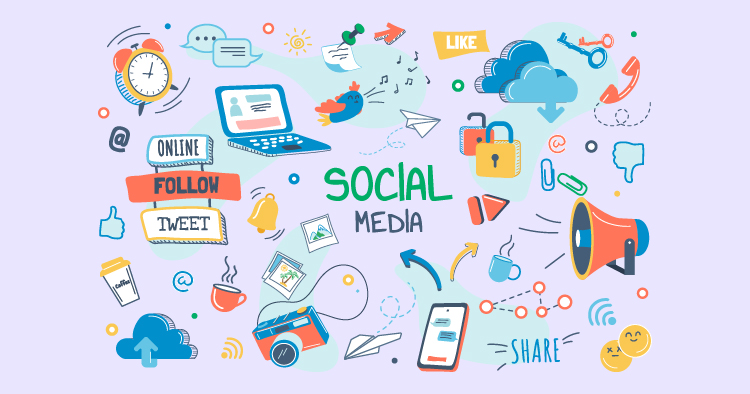When businesses try to enhance their online presence, knowing how to balance free (organic) and paid advertising on social media is essential. Organic reach is all about using non-paid methods to connect with more people. It’s often viewed as more genuine and can build trust with your audience. But, it may take a while to see significant growth this way. Paid advertising, however, can quickly put your brand in the spotlight and allow you to target your ads very specifically. The downside is that it costs money. Using organic and paid approaches is essential to develop an effective social media strategy. Doing this creates a well-rounded way of making your brand appealing and noticeable in a place with lots of competition.
What Is Organic Social Media Content?
Organic social media content is anything you post for free. You don’t pay to see it by more people; it’s the pictures, statuses, tweets, and videos you share on your profiles. The number of people who see these posts depends on your followers and their interaction with your content.
What’s unique about organic content is that it spreads naturally. If people like what you post, they’ll share it with their friends, who might share it with their friends, and so on. This way, your content can reach new people without paying for it.
Organic content is great for building a community. It’s not just about selling something; it’s about sharing useful or fun information, starting conversations, and connecting with people interested in your brand.
Think of organic social media content as the heartbeat of your online identity. It’s what keeps your brand alive and engaging with people every day.
What Is Paid Social Media Content?
Paid social media content is essentially advertising you pay for to reach a broader audience on social media platforms. This includes ads in the traditional sense and promoted posts, sponsored stories, and any other content you fund to target a specific group of people. You can tailor this content to reach users based on their demographics, interests, and behaviors.
This type of content is different from what you might post for free. It usually has a clear marketing message and is crafted to prompt an immediate response, like clicking a link, signing up for a newsletter, or purchasing. Paid social media is beneficial when you want to ensure your message is seen by a particular audience quickly, without the uncertainty of organic reach.
Pros & Cons of Organic Social Media
Conversely, organic social media is content you post without spending money on promotion. It’s a cost-effective way to engage with your audience and nurture a community around your brand. This kind of content can help establish a genuine connection with your followers because it often feels more authentic and less like a sales pitch.
Struggling with Digital marketing? Book Your Free Strategy Session!
- 30-Minutes Session
- Expert Insights
- Data-Driven approach
- Optimized Strategies for Your Goals
Organic content is also more credible since users share it within their networks. When someone sees that a friend has interacted with your post, they’re more likely to trust and engage with your brand.
However, organic social media has challenges. Your content’s reach is generally limited to your current followers and their connections, so getting your message out to new eyes and growing your audience can be challenging. Plus, as social media algorithms become more complex, organic content often gets lost in the noise. This means that even your existing followers might miss your posts amid the vast amount of other content in their feeds.
Pros of Paid Social Media
One of paid social media’s most significant advantages is its targeting capabilities. Platforms like Facebook, Instagram, and LinkedIn offer powerful tools that allow you to reach specific groups of people based on their interests, behaviors, location, and more. If you have a clear picture of your audience, you can ensure your ads are seen by the people most likely to be interested in your products or services.
Another plus is that paid social media campaigns are highly scalable. If you find an ad that resonates with your audience and performs well quickly, you can increase your investment to amplify its reach. This can be a quick method of expanding your customer base and driving more sales.
Cons of Paid Social Media
On the downside, the costs associated with paid social media can be a barrier, particularly for small businesses or startups. Running effective campaigns often requires a significant budget, and there’s always the risk that the return on investment may not be immediately evident. Plus, your visibility on these platforms drops sharply when you stop paying for ads.
There’s also the issue of trust. Many social media users are becoming more skeptical of sponsored content, preferring organic brand interactions. Paid content may not receive the same level of engagement as organic posts, making it less effective for building long-term relationships with your audience.
How To Integrate Paid and Organic Content for the Most Success
Creating a solid social media presence starts with organic content. Share posts that truly reflect your brand’s voice and personality. This kind of content helps you connect with your audience and encourages them to engage with your brand naturally. Think of it as laying the groundwork for a relationship with your followers.
Once you have a variety of organic posts, pay attention to which ones get the most interaction. These are the posts that resonate with your audience. You can extend their reach by putting some budget behind these high-performing posts. This strategy ensures that you’re investing in content with a track record of success.
Paid promotions are powerful when you have a specific goal, like introducing a new product or highlighting a special deal. Your paid content can reach the right people at the right time thanks to the precise targeting options. This targeted approach means your message will more likely get those genuinely interested in your offering.
Analyzing and Adjusting Your Approach
Monitoring the performance of your organic and paid content is crucial. Look at engagement, reach, and conversion metrics to understand what’s working and what’s not. If a specific type of organic post is doing exceptionally well, creating a paid campaign with similar content might be worthwhile to maximize your impact.
By carefully combining organic and paid social media content, you can create a robust online presence that engages your current followers while reaching new potential customers. This blend allows you to achieve specific business goals without overspending, ensuring that your social media marketing efforts are effective and cost-efficient. Keep experimenting, measuring, and refining your approach for the best results.
Final Thoughts
It’s not just about how much money you spend to perfect your mix of free and paid social media activities. It’s also about knowing who you’re talking to and what you want to achieve. A good strategy uses the trustworthiness of organic posts and the broader audience you can reach with paid ads. Monitoring your results and tweak your plan as needed is wise to keep the balance right. The main thing to remember is to stay adaptable and keep up with changes in social media. This way, your brand stays exciting and relevant no matter where you engage with your audience.



